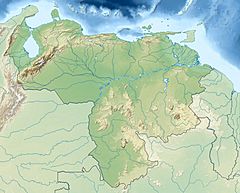Aroa River (Venezuela) facts for kids
Quick facts for kids Aroa River |
|
|---|---|
| Country | Venezuela |
| Physical characteristics | |
| River mouth | Boca de Aroa, Falcón, Venezuela 10°41′05″N 68°17′49″W / 10.684818°N 68.296895°W |
The Aroa River (which is Río Aroa in Spanish) is a river located in the northwestern part of Venezuela. It flows next to and to the west of the Yaracuy River. The Aroa River eventually empties its waters into the Caribbean Sea.
This river helps drain a dry forest area known as the Lara-Falcón dry forests ecoregion.
Contents
History of the Aroa River
Early Discoveries
People knew about gold in the Aroa River area as early as the 1500s. In 1605, more gold was found in a small valley that led to the Aroa River.
The king of Spain later gave the Aroa mines to a person named Dr. Francisco Marín de Narváez. He and his family were allowed to own the mines forever. In return, they paid the king 40,000 pesos.
Copper Mining and Modernization
Much later, in 1824, British business people rented the mines. They started digging for copper instead of gold. The Aroa River became very important for their work. They used barges, which are flat-bottomed boats, to carry the heavy copper ore down the river to the coast. From there, the copper was loaded onto ships.
The town of Aroa, which was close to the mines, became very modern for its time. It was the first town in Venezuela to get electricity. It also had the country's first telephone service. To make moving the copper easier, a special cableway was built. This cableway connected the mines directly to the town.
Sources
See also
 In Spanish: Río Aroa para niños
In Spanish: Río Aroa para niños


